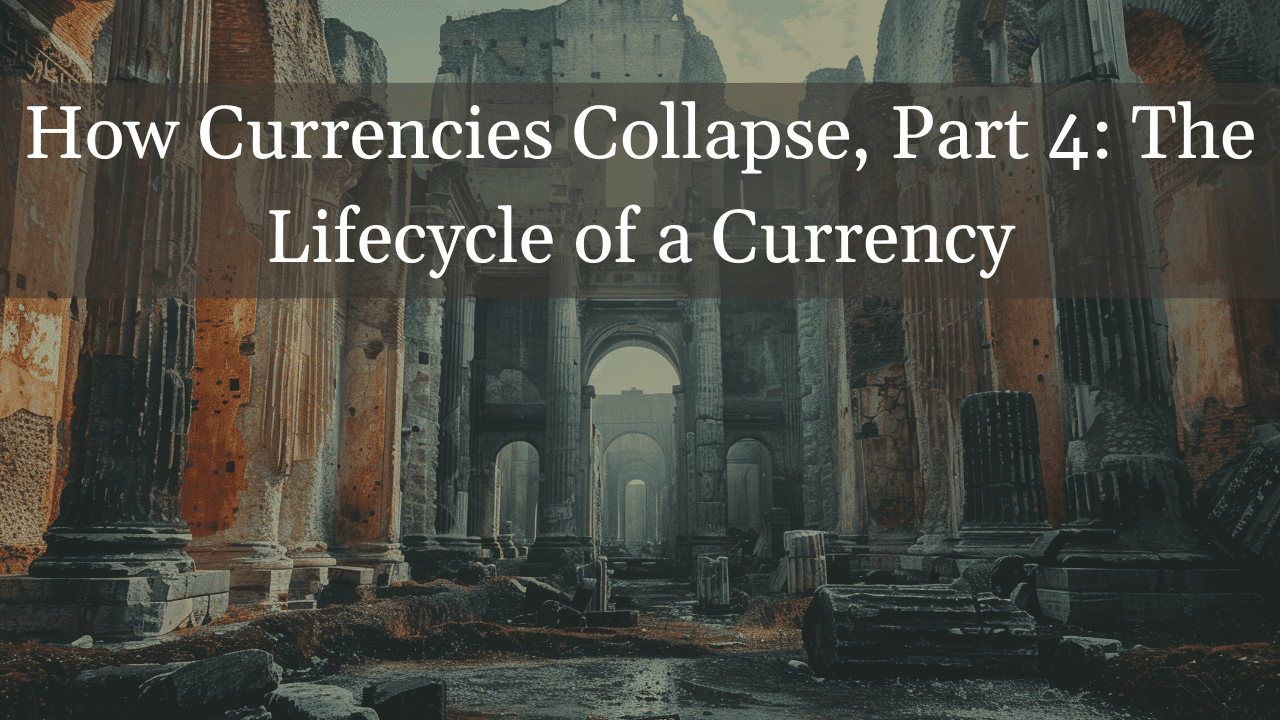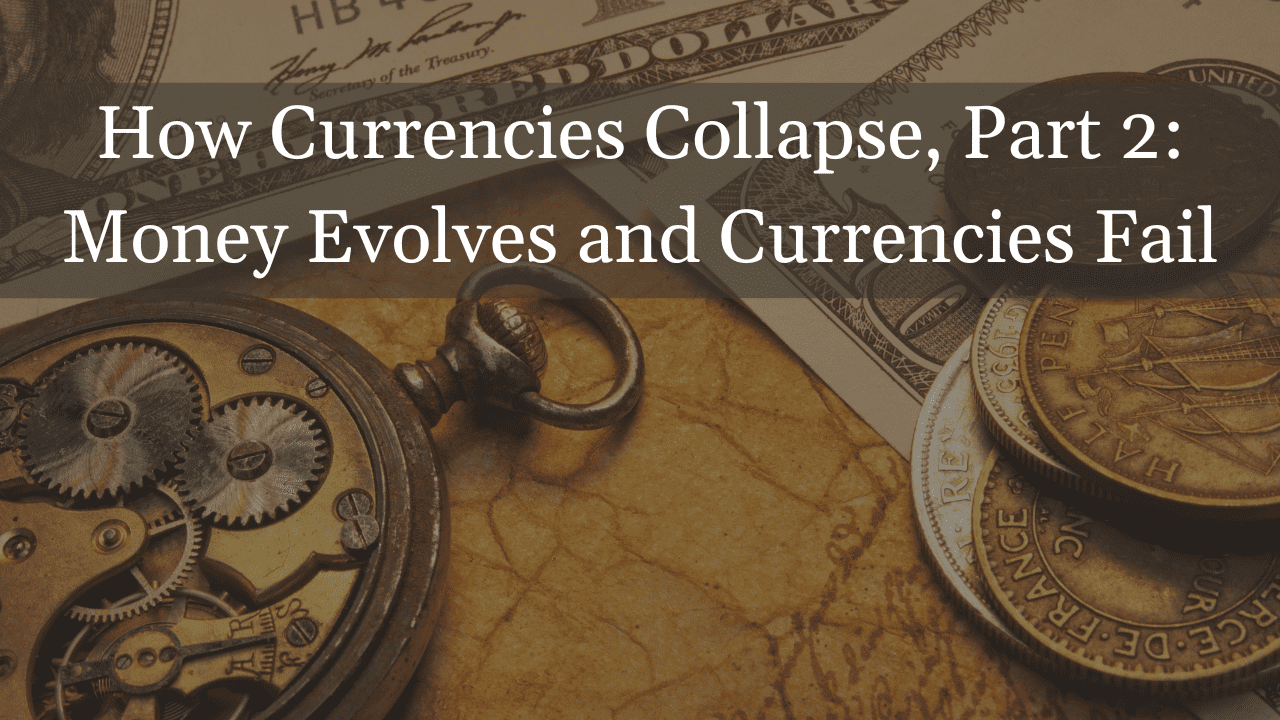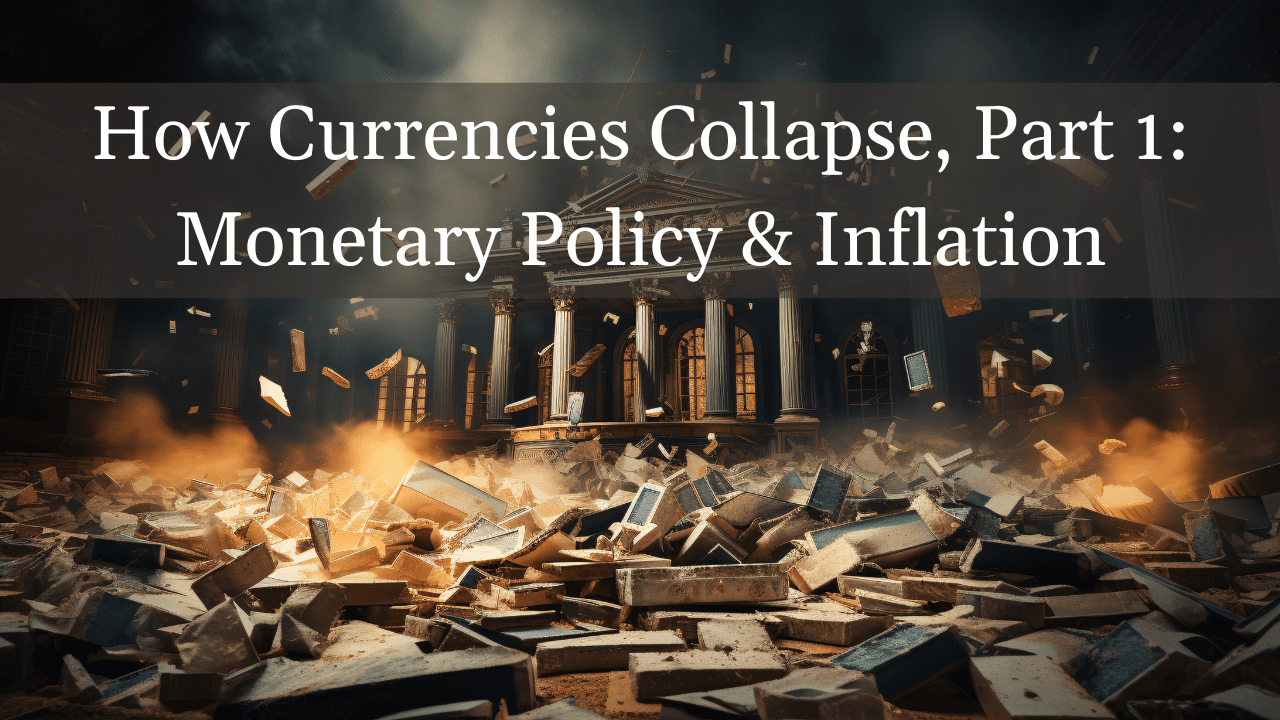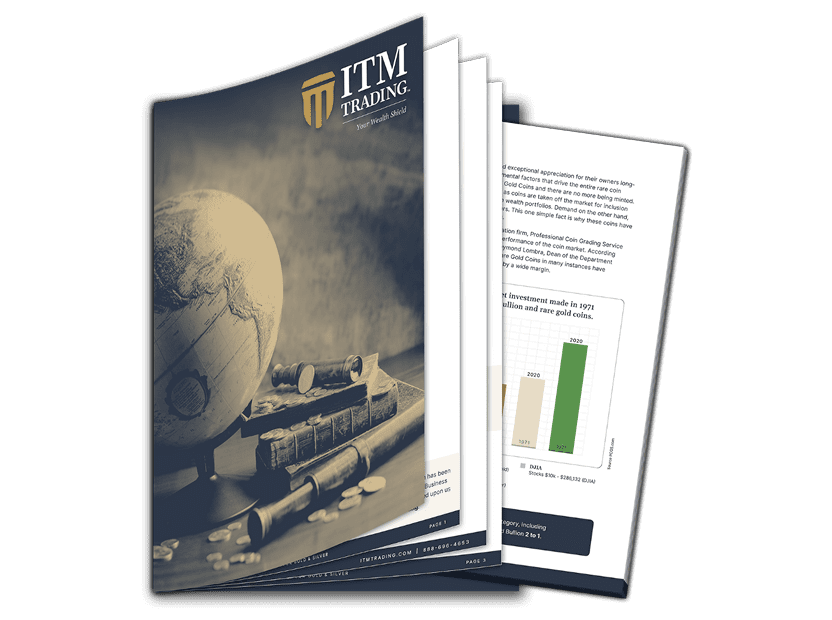How Currencies Collapse, Part 4: The Lifecycle of a Currency

When Currencies Collapse
In the first three parts of this series, I demonstrated how what we are experiencing in the U.S. is best described as a slow-motion currency collapse. It’s reminiscent of the character in Hemingway’s novel, The Sun Also Rises, who is asked how he went bankrupt. “Two ways,” he answers. “Gradually, then suddenly.”
History is unforgiving in this matter. Currencies that are unbacked by anything tangible, and can be created in unlimited quantities by governments or central banks, always fall to their innate value: zero. Some may have endured for centuries. Others are here and gone in the blink of an eye, especially if they’re created in places with challenges such as general economic instability, rapid and frequent changes of political rule, or shifts in technology or global trade. But they all wind up in the same trash bin.
How and at what speed it happens varies. I’ve looked at some contributing elements in Parts 1-3, and have by no means exhausted the list. I will look at others in due time. But since collapse has been the ultimate result for so long, in so many times and places, it seems we should be able to model the process, shouldn’t we? If we look hard enough at the historical record (or maybe if we just look at all), won’t we discover a pattern?
I think so.
Armed with that, we can consider where our present currency situation stands in relation to the model. Then perhaps we make some reasonable guesses as to what the future holds, though I tend to agree with essayist Thomas Carlyle’s pronouncement that economics is “the dismal science.”
I’d suggest that econ is not a science at all. To me, it’s more akin to a mating between art and magical realism—despite that modern economists win Nobel Prizes for complex mathematical theorems purporting to explain things that happen in a rather disorderly marketplace.
Thus I grant that identifying the stages in the life cycle of a currency is admittedly arbitrary. Yet I also acknowledge Mark Twain’s observation that “history doesn’t repeat itself, but It often rhymes.” So let’s take a shot at currency cycles. Using six as a workable number, let’s look at at America through their prism.
Stage 1, Birth:
Every emerging nation, no matter how exalted its destiny might be, starts from scratch. It’s necessary that a currency be introduced by the governing authority, and that it be accepted by citizens, otherwise economic transactions won’t happen. America, before the Revolutionary War, was not a country and didn’t have its own currency. It was forced to use its overlord’s money, the British pound, although the Spanish peso was also widely accepted.
But as war came, the troops had to be paid and supplies bought with something. So the first Continental Congress ordered the issuance of a “bill of credit,” a paper currency called the continental. It did not go well. Once independence was achieved, holders of continentals expected be paid back in real money, like gold or silver. Tough luck. Wars are expensive, continentals were printed in great volume, and soon their value dropped to zero, our first currency default. People began using pesos again.
Stage 2, Establishment and Stability:
Once introduced, a currency must become established as legal tender and stabilized. Thereafter, it gains acceptance within the economy, and becomes widely used for transactions, at first domestically and then internationally. The Constitution (fully ratified, 1788) took the first step in the U.S., stating in Article I that “No State shall make any Thing but gold and silver Coin a Tender in Payment of Debts.” This left two loopholes: states were prohibited from printing legal tender paper currency, but the federal government wasn’t; and private banks could also issue currency.
This is the period of experimentation with money. The United States dollar (USD) was created in 1792 and the new U.S. Mint began turning out coin. Although it’s undergone changes along the way, the USD has endured for over 240 years.
As the new nation prospered and grew, its money consisted only of gold and silver coins. Some local banks also issued paper currencies, and these circulated according to the faith users had in the issuers. In 1861, President Lincoln needed extra cash to finance the Civil War and non-interest-bearing Demand Notes, which became known as “greenbacks,” were printed into existence. They were not initially redeemable in precious metals, and they sank in value until convertibility to gold was established by law in 1875.
In 1862, Congress authorized a new class of currency known as “United States notes” or “Legal Tender notes,” to replace Demand Notes. These notes became the model for all U.S. paper currency and hung around until 1971.
Stage 3, Maturity to Peak:
These are a currency’s golden years, so to speak.
Between 1862 and 1971, the USD continually gained in strength and reached its peak in terms of usage and stability. Too much happened along the way, in terms of fluctuating gold and/or silver standards, to detail here. But some key developments must be noted. In 1913, the Federal Reserve was founded, and Federal Reserve Notes came into existence; they became the standard paper currency from then until today. Gold certificates continued until 1933, when Franklin Roosevelt ordered them removed from circulation. Silver certificates, redeemable for those lovable silver dollars, lasted until 1964, as older readers will remember.
After 1964, the USD became a fully fiat currency (i.e., backed by no physical commodity), although foreign banks could still exchange notes for gold until 1971. That’s when President Nixon “closed the gold window,” ending convertibility for good. Those holding notes expecting to redeem them were out of luck. Another currency default.
It is during the peak period when a nation’s money may become a reserve currency, widely if not exclusively used in international trade. It becomes accepted throughout most of the world, and is held by central banks of other nations as part of their foreign exchange reserves. Like others before it, from the Roman solidus to the British pound, the USD attained this height. It had become a de facto reserve currency in 1921, right after World War I (largely because America had been flooded with gold exchanged for armaments). Then, after World War II it was, essentially, the last currency standing. In 1944 at the Bretton Woods Conference, delegates from 44 other nations made it official, agreeing that the USD would henceforth serve as the global reserve.
Stage 4, Decline:
No nation’s currency hogs the world’s stage forever. History is clear on this. In fact, since 1450 there have been six major reserve currencies and their average reign was only 94 years. If we use 1921 as our starting point, the USD is getting long in the tooth.
Originally, according to the Bretton Woods agreement, the dollar was pegged to gold. It could be argued that the removal of that peg in 1971 marked the beginning of its decline. Certainly the USD’s massive loss of purchasing power since then is a good indicator that we’re in that slow-motion currency collapse. The you-are-here arrow is somewhere on the downslope of the curve.
Stage 5, Reform or Replace:
At some point a nation in the midst of financial floundering, but believing it can still stave off disaster, will be forced to take drastic measures. Revving up the printing press doesn’t work. Think of Zimbabwe, which tried to pawn off trillion-dollar notes as money. (Proponents of Modern Monetary Theory, or MMT, believe that there is no problem, that we can create new currency indefinitely with no consequences—but dealing with them will require a future post of its own.)
One possibility is reform through a simple revaluation, as Argentina has recently done with the peso. Another ploy is to declare old notes no longer legal tender, and replace them with new ones, as France did in 1960—devaluing in the process. (One new French franc equaled 100 old ones, costing citizens about 50% of their purchasing power.) Another is to peg a native currency to one perceived as stronger and more stable, as many countries have done with the USD. China is one of those, its ties to a stable USD aiding in its economic growth. (But it’s a tough task if you already control the “strongest” currency).
The nuclear option is to completely reinvent the monetary system. That already happened in the U.S. in 1933, when government outlawed the private ownership of gold (real money) and ordered citizens to trade theirs in for a devalued paper dollar. Today gold is back as a store of value, and doing quite well. But the dollar has been savaged. The obvious way forward would be a deep recession that reverses inflation, rewards savers, and helps restore some of the USD’s lost value. But that also means a decline in GDP and lost jobs. Both politicians and the Fed fear this (harboring memories of the Great Depression) and will do everything possible to prevent it. Instead, they are prepared to promote inflation, which benefits their Wall St. cronies and harms everyone else.
The U.S. is presently somewhere in Stage 4. Will we fall to Stage 5? Probably. If we do, what will happen then? No one knows. But some folks in high places have been laying the groundwork for their “solution” for several years now: adoption of a central bank digital currency (CBDC) as the only form of money. If you value your privacy, this is your worst nightmare. A CBDC system would abolish all cash, either physical coins or paper, as legal tender. Checking accounts and credit cards would vanish. Everyone would get a digital account at the Federal Reserve, and all transactions would involve credits and debits to these accounts.
This would be an unprecedented extension of power over the people, something out of a dystopian novel by Philip K. Dick. It would enable government not only to set the value of digital dollars, but also to completely control commerce. Every cent you earn or spend would be tracked. Ideologically-programmed computers would decide what you could or could not spend your money on. This could be tied to a “social credit” system, such as already exists in China. Your CBDCs could be frozen at any time, for any reason. Government could pillage accounts if it had a need for “emergency funding”—by its own definition, of course. Your whole financial existence would be fraught with insecurity.
“It won’t happen here,” you say? Well, I hope you’re right. Because it could.
Stage 6, Death:
If enough economic forces align against a currency, it can completely collapse. This is an old, old repeated story, from Rome to Weimar Germany to Zimbabwe. When the public’s faith in their money goes, hyperinflation is the first result. Then chaos. The country usually comes apart—politically, economically, socially—and public sentiment swings toward an authority figure who promises to “fix things.” At best, the nation may be able to hang on as it builds confidence in a new monetary order. At worst, you get Hitler.
The USD has enjoyed a long run of global dominance. That hegemony is fraying due to many factors, including fiscal mismanagement at home and the rise to prosperity of other nations. We don’t know when, but its status as the reserve currency of the world will end. And at that point, our strength as a unified people will be tested as it hasn’t been since the 1860s. No one can predict the outcome.
By Doug Hornig
Contributing Author, ITM Trading
www.itmtrading.com
P.S. Worried about the impact of inflation and unstable monetary policies on your financial security? Don’t wait until it’s too late! For over 28 years, we’ve guided thousands in safeguarding their wealth and securing their retirement against potential currency collapses. Schedule your free consultation today to explore protective strategies tailored for you. Call 866-953-7929 or click here to schedule your consultation now.









